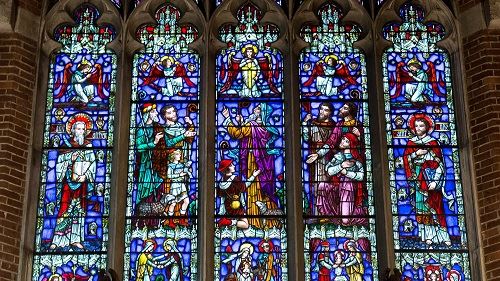About Us: Stained Glass
- Welcome
- About Us
- Our Church
- Stained Glass
Stained Glass“For at the window of my house I looked out through my lattice.” Proverbs 7:6 Epiphany's beautiful stained glass continues the medieval tradition of a “book of Bible stories.” An essential part of the overall plan of the building, each window shows some manifestation of Christ to the world, illustrating the idea of Epiphany and telling the story of Christianity's spread around the world. While many of these windows date from the construction of the building, others date from much later; the small windows in the chancel and those along the tower stairway were installed within the past couple of decades. As would be expected, the windows show a variety of styles, although they are unified by their size and shape, and the architectural elements used in most of their frames. Chapel of PraiseChapel: OverviewIn the middle ages, the images in stained glass were intended to serve as illustrations of Biblical and other sacred texts for the enlightenment of largely illiterate congregations. This tradition is delightfully continued in the Chapel of Praise-itself a memorial to The Rev. Charles Batten-where the stained glass forms a single unified composition illustrating The Song of Creation (Book of Common Prayer, page 47), the first line of which is emblazoned on a banner that wends its way from one end of the wall to the other. The total composition is divided into fifteen lancets, which are then regrouped into five triplets of three lancets each: The first two triplets (six lancets) deal with the cosmic order. The next two (six more lancets) treat the earth and its creatures, and the final triplet (three lancets) celebrates the people of God. With the exception of the first triplet, all three lancets of which constitute a single memorial to Margaret Stevenson McCreerey, the other lancets are all individual memorials. At the top of each triplet is a group of symbols of the faith. Throughout the composition one finds little decorative panes, some relevant to the subject matter at hand, and others added purely for delight-the artisans' "noodling around" in the medieval tradition. Chapel: Triplets I and II "The Cosmic Order"
Lancet I-2: The planets, winds, waves, storms. Top: Star (symbolic of the sixfold attributes of God the Father: Wisdom, Power, Majesty, Love, Mercy, and Justice) shedding rays of light (the Holy Spirit, or Jesus) and sanctifying the creation. Lancet I-3: Rain, sleet, winds, the fertile earth, and the rainbow (God's promise after the flood). Top: The castle probably represents the Heavenly Jerusalem, although Martin Luther's Mighty Fortress is also a possibility.
Lancet II-2: The four seasons: Spring (top) and Summer. Top: Flame, symbolic of the Spirit of God (as, for instance, in the story of Moses and the burning bush). Memorial to John Eugene Rines. Lancet II-3: The four seasons: Autumn (bottom) and Winter (Note the circular, cyclical, presentation. The seasons go 'round counterclockwise, interrupting the left-to-right progression of the windows as a whole). Top: Left hand extended in blessing (symmetrical with Lancet II-1). Memorial to Margaret Blake Hadley. Chapel: Triplets III and IV "The Earth and Its Creatures"
Lancet III-1: The earth-mountains and hills, rivers and streams, and volcanoes. Top: A golden square, representing the four gospels, in a circle, a form without beginning or end-symbol of unity and especially, eternal life. Memorial to Beatrice Jones. Lancet III-2: The ancient beasts-dinosaurs and ancient birds. Top: The triangle represents the Holy Trinity, and in the center, the unblinking watchful eye of God (Note that this is the exact center of the overall composition). In honor of the Women of Epiphany. Lancet III-3: The birds of the air. Top: The orb, composed of the circle with a "T" cross, taken from the mappa mundi, or ancient map of the world, surmounted by the Cross of Christ-in all a symbol of Christ's sovereignty over the world. Memorial to Purney Parkin.
Lancet IV-2: Domestic creatures-Oxen, sheep (symbolic of the Christian people), horse, and dog (faithfulness). Top: Golden hexagon, perhaps symbolic of the six days of creation, or of the sixfold attributes of God (see Lancet I-2 above). Memorial to Thomas and Vesta S. Jope, and Gertrude R. Jope. Lancet IV-3: Creatures of the wild-Ibex, giraffe, elephant, and lion (yet another symbol of resurrection). Top: A throne, which likely represents God through Revelation imagery. Memorial to Herbert Todd Wadsworth. Chapel: Triplets V "The People of God"
Lancet V-2: The people at prayer-Above, a priest celebrating the Eucharist, and below, people at prayer. Top: The crown represents Christ the King. Memorial to Charles Edward Batten. Lancet V-3: The saints of God-Above, a religious scene, and below, the peoples of the world (figures representing Africa, China, India, and Europe). Top: Scales in which all souls will be weighed at the Last Judgment, representing justice. Memorial to Frank W. and Eleanor H. Abbott. Stained Glass in the Common RoomsHadley Hall
It is a typical example of inexpensive late nineteenth-century commercial stained glass, with its simple geometric forms and colors reminiscent of those found in the chromolithographic illustrations that were so popular from the 1880s well into the twentieth century. The window was restored and installed in its present location as a memorial to Hester Keller. Old Parish Hall
The window is divided into two courses vertically. The lower course is divided into five panels, and the upper course serves as a transom, extending into the arch of the window. Each panel is surrounded by a border of oak leaves and acorns, with squares of plain green or blue glass separating the individual border lights. The central fields are set with wavy clear glass. The outer and central panels are taller than those between them, rising into the arch. Each contains near the top a tondo (circular image) framed by a green laurel wreath, bound with red ribbon and ornamented with Tudor roses, and a rectangular cartouche near the bottom. The left tondo depicts Hanna and the boy Samuel. The cartouche below contains the legend "A teacher and lover of children". The central tondo contains an image of the Virgin and the Christ Child, and in the cartouche below, "Myra Inman Higgins". St. Monica and the boy St. Augustine are depicted in the right tondo, beneath which is the legend "The gift of her family A.D. 1927." The smaller panels are ornamented only by the oak-leaf-and-acorn border. The transom contains six smaller panels with guilloche-like borders. In the center of each is a disk bearing a Tudor rose. This window is a memorial to Myra Inman Higgins. The ChancelThe Chancel: Overview
The Chancel is the part of a church near the altar, reserved for the clergy and choir, and typically separated from the nave by steps or a screen. The large window over Epiphany's altar illustrates the story of the shepherds in the fields from Luke 2 (the actual Epiphany “the arrival of the wise men” is depicted in the tapestry below). The flanking windows on the side walls represent Old Testament figures to the south, and Apostles to the north.
Altar window
The shield with the cross held by an angel is the theological heart of the window, and indicates where all this excitement and wonder is leading. Note that the cross is radiant, and therefore representative of the Resurrection, not Good Friday. The five panels at the bottom of the window depict scenes connected with Jesus' infancy-the annunciation, the meeting of Mary and Elizabeth, the flight into Egypt, the circumcision or naming of Jesus, and Jesus and the elders in the temple. Even though this window stands in the Parish of the Epiphany, it makes no mention of the Epiphany itself-visit of the wise men from the East. That job is left to the tapestry made to hang on the reredos below. The window was given in memory of Sophy McPhee, and is the work of the Wilbur H. Burnham studio. Old Testament windowThe window in the south wall of the sanctuary, to the right (Epistle) side of the altar, shows Old Testament figures who typified some characteristic of Jesus: The law-giver—Moses with the tablets of the law. He carries a rod, and is always represented with a beard and with rays of light (sometimes misrepresented as horns) coming from his forehead. The words on the scroll are from Deuteronomy 6: 5, “Thou shalt love the Lord thy God.” The prophet—Isaiah, prophet of the exile, writer of second Isaiah, a great missionary prophet and man of world-wide vision. The words, “The Lord shall be unto thee an everlasting light and thy God thy glory,” Isaiah 60:19, are found on the scroll. The poet—David, writer of the Psalms, and a shepherd when a boy, as symbolized by his shepherd's crook. He carries a harp. The words on the scroll, “The Lord is my strength and song,” are from Psalm 118:14. New Testament windowThis window, on the north sanctuary wall, to the left (Gospel) side of the altar, represents three great apostles from the New Testament: St. John the Apocalyptist, seer of Patmos-A man of wide-reaching vision, writer of the Book of Revelation words from which are on his scroll: "I saw the Holy City, the New Jerusalem" (He is usually represented as an old man). The iconography of this window reflects the traditional view that the fourth Gospel, the Book of Revelation, and the letters of John were all written by the same John. The cup which he carries in this image-from which a winged snake is emerging-is a reference to the legend concerning St. John the Evangelist that he could drink poison without untoward effect. Most contemporary biblical scholars now believe that the "John writings" have three separate sources-that the Gospel was written by one hand, Revelation by another, and the letters by members of the community writing in John's name. Nevertheless, a substantial minority of scholars does not accept this view, and continues to ascribe all the writings to one man. St. Paul-the great apostle to the world. He carries the "the sword of the Spirit," usually seen in pictures of him, and also a book, symbol of his writings and teaching. Over his head is a scroll with the words, "There is neither Greek nor Jew, barbarian, Sythian, bond nor free, but Christ is all in all," from Colossians. 3:11. St. Luke-disciple, physician, and companion of St. Paul, author of the gospel of boundless compassion for humanity. The words on the scroll, "When he was yet a great way off his father saw him," are from the parable of the prodigal son, found only in St. Luke's gospel. The dedication plaque bears the legend, "Murray Wilder Dewart/ Rector of the parish 1912-1922/ A Chaplain of the 101st I. A. 26th Division A. E. F. 1917 to 1919/ February 14, 1874 to December 4, 1922" Sacrament windowsThe two small windows in the north wall of the choir represent the sacraments of the church-Baptism and Eucharist. In the left window, Baptism is symbolized by the font, with the dove (representing the Holy Spirit) descending in a glory and crowned with a nimbus, and a shell, symbol of Christ's baptism. The right window symbolizes the Holy Eucharist, showing the bread and the cup, surrounded by grapevines and sheaves of wheat. They are a memorial to Edward Thomas and Bertha Bassett Broadhurst, and James Bennett and Ethel Cox Lowell. The Nave: Central Street sideWindows on the Central Street side of the nave represent New Testament saints.
Shafer windowPanels: Left-St. Stephen, a young martyr and one of the first deacons appointed by the early church, was stoned to death because of his successful preaching of Christ. He holds a stone-symbol of his death-in his hand, and carries a palm, symbol of victory over death. His initials are in the background. Right-St. Timothy, a young bishop, friend and disciple of St. Paul He wears a miter and carries a staff, symbols of his office. He also carries a book, symbol of a teacher and a pastor. Note the initials in the background. While in the next window St. Stephen looks up, St. Timothy looks forward, expressive of youthful idealism and promise. Scene-Jesus in the temple talking with the elders. Like many of the nave windows, this window was made in England by Kempe. Their trademark, a sheaf of wheat, is found somewhere in each of their windows. Given "in memory of a boy," Harry G. Schafer, 1880-1895. Huntress windowPanels: Left-St. John the Evangelist, one of the twelve disciples, sometimes called beloved. He holds a cup from which a winged serpent rises, symbolizing his supposed ability to drink poison and not be harmed by it. His symbol is the eagle, which flies higher than any other bird, symbolizing inspiration and the flight of the spirit. At the time this window was designed, it was generally believed that the same St. John was the author of the fourth Gospel, the Book of Revelation, and the letters of John. A majority of scholars now believes that these writings originate from three different sources. Right-St. Andrew, one of the twelve disciples. We see a cross, named after St. Andrew because because this type of cross is thought to have been the instrument of his death. He is the patron saint of Scotland; in the background are thistles, the flower of the Scots. He also carries a book, symbol of the teacher. Scene-John the Baptist pointing out Jesus to Andrew and John. Given in memory of a young man by his parents in 1908. May windowPanels: Left-St. Barnabas, a prominent member of the early Church, a companion of St. Paul on his first journey, and cousin of St. Mark. He holds in his hand a scroll with the words, "Son of consolation"(Bar-nabas), or comfort. He was so called because of his generosity to the poor of the first Christian community. He holds a book as symbol of a teacher. Right-St. Mark, a member of the early Church, companion of Peter, and writer of one of the gospels, but not one of the twelve disciples. It was possibly in his mother's house that the last supper was held. The symbol of St. Mark, always found in any picture of him, is the lion. He holds a book as writer of a gospel. His initials are in the background. Scene-St. Paul preaching in Athens. The words, "Him I declare unto you," refer to an altar marked "To the unknown God," which Paul found there among the statues of the Roman gods, following which he explained that he had come to tell them about this god. Given in memory of Marcus B. May, 1869-1933, for many years a Warden of the parish. Bunting windowPanels: Left-St. James, one of the twelve disciples. He carries a staff and scrip, and is considered s patron saint of travelers. He wears on his shoulder the scallop shell, symbol of the pilgrim (The greatest of the medieval pilgrimage routes led through France and Spain to the church of St. James in Compostela). Right-St. Peter, one of the twelve disciples and leader in the early Church. He carries in his hand his symbol, keys, signifying that he had the power to open the gates of the Kingdom of Heaven, (Matthew 16: 19). He also holds a book, symbol of a teacher. Scene-The marriage at Cana, where Jesus turned water into wine. Given in memory of James F. Bunting and Carrie E. Bunting, given by Blanche G. Bunting. Higgins windowPanels: Left-St. Philip was one of the Twelve, and figures in several incidents in John's gospel. Notably, in response to Jesus' question of how they would get bread to feed the five thousand, his response that "two hundred denarii would not buy enough" sets the stage for the miracle of fishes and loaves. Right-St. Bartholomew, another of the Twelve, is known to us only by being listed by name in three of the Gospels. Traditionally he was martyred by being flayed alive, and is shown here holding his symbol, a skinning knife. Scene-Jesus feeding the five thousand (the miracle of the loaves and fishes). Given in memory of Alfred Sawyer Higgins. Hadley windowPanels: Left-St. Matthew was a tax collector before Jesus' call to join the Twelve. The inclusion of such a person in Jesus' band of disciples was a dramatic statement of the inclusiveness of his Gospel (tax collectors were widely viewed as corrupt collaborators with Imperial Rome). St. Matthew is customarily represented holding a purse. He is thought to have died of natural causes. Right-St. Thomas appears to have been a thoughtful if rather literal-minded man. His honest questioning and doubt, leading to Jesus' assuring response, has given many Christians courage to persist in their faith, even in the face of doubts and questioning. The spear he holds probably refers to the instrument of his martyrdom, although some traditions hold that he was dispatched be the glaive (broadsword). Scene-The Transfiguration. This scene represents the only significant departure from the Suter-Smith plan for the nave windows. The original plan called for this scene to depict Jesus and the Samaritan woman. Given in memory of Dwight W. Hadley, 1888-1957, fifth rector of the parish from 1931 to 1952. This window is best seen from the choir balcony. The Nave: Cloister Garden sideThe windows on the other side show later saints through the ages.
Olmstead window
One of his symbols is three golden balls, after a story of his leaving purses of gold secretly on three successive nights at the home of a ruined family, thus redeeming the daughters, who would otherwise have had to lead "lives of shame." From this tale come both the tradition of St. Nicholas as bringer of Christmas gifts and the traditional pawnbroker's sign. Right-St. Christopher, always represented standing in water and carrying a child on his shoulder. The child holds in his hand an orb surmounted by a cross, symbolizing Christ's dominion over the whole world. The story of St. Christopher (Christ-bearer) tells how the saint unknowingly carried the Christ child over a turbulent river on a stormy night with great danger to himself. The child grew heavier and heavier as the storm increased and the river became more dangerous. Tradition holds that the heavy weight of the child was due to the burden of man's sin that Christ bore. Scene-Christ blessing little children Given in memory of a young mother and baby by William S. Olmstead, 1924. This window is best seen from the choir balcony. Page windowPanels: Left-St. Martin, fourth-century bishop of Tours, initially was a Roman soldier, following which he became a monastic. He was elected bishop by popular acclamation, rather against his will. He was unpopular with his fellow bishops, due to his uncomfortably ascetic way of life and his opposition to his colleagues' persecution of heretics. This window illustrates the legend that before his baptism, when approached for alms in the name of Christ by a beggar, he cut his cloak in two with his sword and gave half of it to the man. Right-Martin Luther was a German Augustinian monk and scholar living in the late fifteenth and early sixteenth century. Profoundly disturbed by what he saw as the corruption of the church, he attempted reform from within, advancing the doctrine of justification by faith alone, the primary authority of scripture, and a greater role for the laity. Excommunicated by the Roman church for his protests against the practice of selling indulgences and his invective against the Papacy, he became a key figure in the Protestant Reformation. A poet, he composed many great hymns, often setting them to popular melodies of the day, reportedly saying that he saw no reason to let the devil to have all the good tunes. Scene-St. Francis preaching to the birds. Within the scene is a variety of Christian symbols, including the peacock (immortality and eternity) and the squirrel (meditation on divine things and spiritual striving). The rabbit is a reference to one of the many tales of the saint freeing captive animals, following which they would come to his arms, receive his blessing, and then follow after the saint. Given in memory of Louis Eugene Page, who died in 1956. Miller windowPanels: Left-St. Swithin, Bishop of Winchester, England, 852-862. He wears the miter and carries the staff of his office. A kindly, holy man, he was noted for doing good works. He asked to be buried in the graveyard outside the church instead of in a place of honor inside. After his death it was decided to move his bones inside the church, but when they started to do so, it rained for forty days. From this event came the tradition that if it rains on St. Swithin's day, July 5, it will rain for forty days thereafter. Right-Thomas Cranmer, Archbishop of Canterbury at the time of the Reformation, appointed by King Henry VIII. He translated the Prayer Book into English, symbolized by the book which he carries. A Protestant, he was burned at the stake by Queen Mary during the brief re-establishment of Roman Catholicism as the State church following Henry's death. Scene-St. Gregory and the English children in the marketplace in Rome. He said, "Call them not Angles [English] but angels," because they were so fair and beautiful. He sent Augustine to Britain to convert the island's inhabitants to Christ. Suter windowPanels: Left-St. Theresa of Spain, a beautiful young woman of wealth who gave up the world and became a nun for love of Christ. She is seen wearing the robe of the Carmelite order. She was a mystic, with unusual spiritual insight. The heart with I H S on it and the book symbolize gifts to the Church (I H S stands for Iesus, hominem salvator-Jesus, savior of humankind). Her initials are found in the background. These two panels represent contrasting types of Christian life-life in the world and monastic life, the philanthropic and mystic ideals. Right-St. Elizabeth of Hungary, a queen who loved our Lord and cared for the sick and poor. Her husband, the king, didn't like to have her do so much, and was afraid that she might catch a disease. It is said that she once took a little child sick with leprosy into her palace and put him to bed. When the king discovered him, he was no longer the leper but the Christ-child. Another story, shown in the window, holds that once when she went out among the sick and poor during a great plague carrying loaves of bread in her skirt. The king saw her and asked her what she was hiding. She showed him, trembling, but the loaves had turned into roses (symbols of the Virgin Mary). Scene-The woman who touched Christ's garment and was healed. Given in memory of Dr. Suter's mother, Emily Bigham Suter, 1834-1885. Dr. Suter, whose notes refer to it as the "Window of Womanhood," was the first rector of the parish, serving from 1885 to 1911. Bradstreet windowPanels: Left-Père Marquette, a French Jesuit priest and missionary in Canada who worked and endured great hardships to convert the Indians. He carries a crucifix and book, symbols of his vocation and teaching. Right-John Robinson, pastor of the Pilgrims at Leyden before they came to this country. Although he never came to America, his wise counsel and teaching had a far-reaching influence on the Plymouth colony and beyond. Scene-The first service at Jamestown, celebrated by Robert Hunt, Chaplain of the ship in which the colonists came. Given in memory of Charles William Bradstreet, for many years a warden of the parish. This was referred to as the American window because it pictures men who did much to Christianize the new land. Given in memory of Charles William Bradstreet, 1833-1908, by Alprosia The Tower and NarthexWindows in the narthex show modern holy men and martyrs in the north wall, and men of the American Episcopal church in the south. The window in the second story, over the main entrance, represents Christ's ascension to Heaven. Ascension windowOne of the "hidden treasures" of Epiphany's stained glass, this window, given in memory of Horatio Frederick Hammond 1857-1938, was installed in the new tower constructed in 1940, replacing a window that formerly stood in the west wall of the nave in the opening where the organ now sits (that window is believed to have been glazed with uncolored "placeholder" leaded glass similar to that in the Acolyte Robing Room). The subject of this window-Christ's ascension into Heaven-balances the Christmas scene in the window above the altar, and thematically ties together all the church windows. The figure of Jesus is central. The apostles and Mary, his mother, are represented as witnesses to the event. In the central lancet upon a conventional cloud-form is the figure of our Lord with upraised hands. He is surrounded by a vesica of glory of glowing tones of ruby. The figure is in raiment of delicate whites and pale yellows, expressing victory and reward. Above his head golden rays of light proclaim his glorious ascension into Heaven. Below are three cherubim with golden halos and ruby wings. In the side lancets, Mary and the group of apostles observe the scene. Their robes of varied colors create a majestic harmony of pattern. The backgrounds of heavenly blue are sprinkled with silvery stars. Each lancet contains a predella in which small angels are introduced. The central angel holds a scroll on which is the memorial inscription. The side angels are playing on musical instruments-the harp and organ. The window is designed to conform to the canopied English windows in the nave but with additional splendor of rich color inherent in the best work of the Middle Ages of France. The scene of the Ascension is wrought in a purely decorative manner and is framed by canopies in silver and gold. The drawing of the figures is essentially modern in spirit. The entire composition is joyous in color, but withal deeply devotional. This window is the work of the Wilbur H. Burnham studio, one of the foremost artists in stained glass of its time in America. The somewhat florid description of the window is Burnham's own. It was given by Mr. and Mrs. Ambrose E. Reasoner in memory of Mrs. Reasoner's father, Horatio Frederick Hammond, who died in 1938. To view this window, use the stair to the second story of the tower. As an aside note, when the parish was discussing moving the choir from the chancel to its present location, one of the objections raised was that the new balcony, and especially the organ, would block the view of this window. They did, and they do, alas. Narthex, north wallRight: Leaders of the ecumenical movement: John XXIII, William Temple, and V. S. Azariah. Pope John XXIII is known for his work to update the Roman Catholic church and his reaching out to all branches of Christ's church. William Temple was an early twentieth-century Archbishop of Canterbury who was among the first important Anglicans to work for ecumenical cooperation. V. S. Azariah, a native of India, was the first non-European, non-white person consecrated a bishop in the Anglican communion when he was elected to the see of Dornakal in 1912. Secondary decoration includes a ship with the Greek word oikumene [the inhabited world], symbolic of the Church Universal, and the shell of baptism and pilgrimage. This window is a memorial to Stephen George Nichols, who died in 1973. Left: Martyrs: Mohandas Gandhi, Dietrich Bonhoeffer, and Martin Luther King, twentieth-century holy men who were all martyred for their beliefs. Gandhi, perhaps the ultimate twentieth-century practitioner of non-violent protest, was shot as his campaign to free India was coming to fruition. Bonhoeffer was hanged by the Nazis for his witness and resistance, and Martin Luther King, in his non-violent approach to advocating civil rights for Afro-Americans a disciple of Gandhi, was shot. This window memorializes Dorothy Ladd Buracker Bigham, who died in 1973. Narthex, above the entrance
- Carpentry (a saw and square), The law (the scales of justice), Meteorology or electrical engineering (lightning and a cloud) - The arts (dramatic masks, a palette, a musical score), Nuclear physics (the atom), The construction trades (a hammer, a power tool) - Sports, enjoyed by Mr. Chase (skis, a curling stone and broom, and tennis rackets), Learning (a lamp and a mortarboard), Agriculture (wheat) - Dedicatory plaque, Industry (an industrial city), Space travel (a space ship traveling to the moon) - Finance (a stock ticker) Narthex, west wallThis window depicts Charles Henry Brent, John and Charles Wesley, and Alexander Viets Griswold: Charles Henry Brent was elected Missionary Bishop of the Philippines in 1901, and devoted the remainder of his life until his death in 1929 to the cause of Christian unity, and in particular to opening dialogue with other Protestant denominations that did not observe the historic episcopate.. He is author of the prayer for mission used in the Morning Prayer service (Book of Common Prayer, page 101). The Wesley brothers, both Anglican priests, and primarily known as the founders of the form of Anglicanism that evolved after their deaths into the Methodist Church, spent time in South Carolina, John as a missionary, and Charles as secretary to the Governor. Alexander Griswold was Bishop of the "Eastern District" of the American church (all of New England except Connecticut) from 1811 to his death in 1843. Under his care the region grew from sixteen priests and twenty-two parishes to five dioceses, encompassing over a hundred parishes. Secondary decorative elements include an angel and a red bird (probably a phoenix, symbol of the resurrection). This window is a memorial to Frederic William and Grace Bertha Moore Aseltine. Stair to the Tower
|



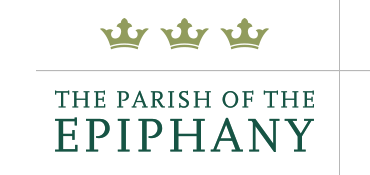


 Lancet II-1: Thunderbolts, sleet, snow, ice. At the bottom, on the frozen earth, burning fire (Some say the world will end in fire, some say in ice.). Top: Right hand extended in blessing. Memorial to Ethel Bradford Davis.
Lancet II-1: Thunderbolts, sleet, snow, ice. At the bottom, on the frozen earth, burning fire (Some say the world will end in fire, some say in ice.). Top: Right hand extended in blessing. Memorial to Ethel Bradford Davis.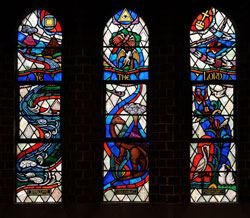 Lancet III-1: The earth-mountains and hills, rivers and streams, and volcanoes. Top: A golden square, representing the four gospels, in a circle, a form without beginning or end-symbol of unity and especially, eternal life. Memorial to Beatrice Jones.
Lancet III-1: The earth-mountains and hills, rivers and streams, and volcanoes. Top: A golden square, representing the four gospels, in a circle, a form without beginning or end-symbol of unity and especially, eternal life. Memorial to Beatrice Jones.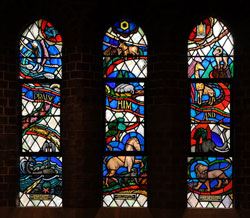 Lancet IV-1: The whales, and creatures of the deep. Top: A triangle of fish, symbolic both of the Trinity and the Eucharist. Memorial to Robert Francis Bowes.
Lancet IV-1: The whales, and creatures of the deep. Top: A triangle of fish, symbolic both of the Trinity and the Eucharist. Memorial to Robert Francis Bowes. Lancet V-1: The people and their work-Above, a bishop, a scientist, and an academic, and below, a soldier, a firefighter, and a nurse. Top: The armored breastplate represents righteousness, and protection from evil. Memorial to "Kim, the Soldier."
Lancet V-1: The people and their work-Above, a bishop, a scientist, and an academic, and below, a soldier, a firefighter, and a nurse. Top: The armored breastplate represents righteousness, and protection from evil. Memorial to "Kim, the Soldier."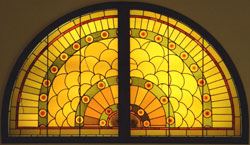 The first church building of The Parish of the Epiphany was a modest Queen Anne style wooden structure located on Mt. Vernon Street across from the Town Hall. The window in the west wall of Hadley Hall stood in a gable facing the street above the entrance porch, and was taken from the building when it was demolished to make way for the building that now (2009) houses the Hope Christian Church.
The first church building of The Parish of the Epiphany was a modest Queen Anne style wooden structure located on Mt. Vernon Street across from the Town Hall. The window in the west wall of Hadley Hall stood in a gable facing the street above the entrance porch, and was taken from the building when it was demolished to make way for the building that now (2009) houses the Hope Christian Church.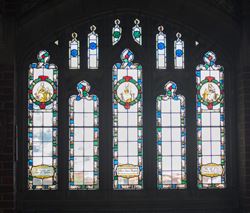 Although all the windows in the Old Parish Hall were originally intended to be completed with stone tracery and stained glass, only one actually was finished, in the center of the garden-side wall. It is not ecclesiastical stained glass, but rather takes its inspiration from late Renaissance English country houses. The stained and patterned glass serves to decorate the window, which is primarily filled with clear glass to allow more light to enter.
Although all the windows in the Old Parish Hall were originally intended to be completed with stone tracery and stained glass, only one actually was finished, in the center of the garden-side wall. It is not ecclesiastical stained glass, but rather takes its inspiration from late Renaissance English country houses. The stained and patterned glass serves to decorate the window, which is primarily filled with clear glass to allow more light to enter.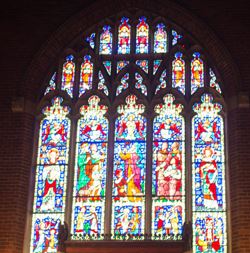 The large lancets of this window illustrate the story of the shepherds as told in the second chapter of St. Luke's gospel. They are in the field with their sheep and stand looking up at the angels and glory that have appeared. The panels on either side represent the writers of the two gospels that tell the story of Jesus' birth-St. Luke at the right with his symbol, the ox, and St. Matthew at the left with his symbol, the winged man's head. In small windows above are Alpha and Omega, the first and last letters of the Greek alphabet, symbolizing Christ as the beginning and the end. In the upper small windows are other angels-the "multitude of the heavenly host."
The large lancets of this window illustrate the story of the shepherds as told in the second chapter of St. Luke's gospel. They are in the field with their sheep and stand looking up at the angels and glory that have appeared. The panels on either side represent the writers of the two gospels that tell the story of Jesus' birth-St. Luke at the right with his symbol, the ox, and St. Matthew at the left with his symbol, the winged man's head. In small windows above are Alpha and Omega, the first and last letters of the Greek alphabet, symbolizing Christ as the beginning and the end. In the upper small windows are other angels-the "multitude of the heavenly host."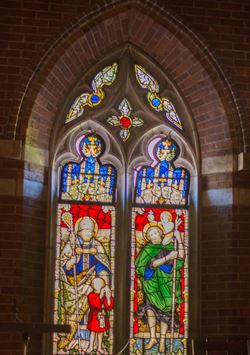 Panels: Left-St. Nicholas, a bishop of the early Church. He wears the miter and carries the staff, symbols of his office. Legends surrounding this saint are rich and varied. He is the patron saint of children, symbolized by the child in the panel, as well as of sailors and merchants.
Panels: Left-St. Nicholas, a bishop of the early Church. He wears the miter and carries the staff, symbols of his office. Legends surrounding this saint are rich and varied. He is the patron saint of children, symbolized by the child in the panel, as well as of sailors and merchants.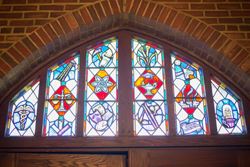 This memorial to Richard Dana Chase, who died in 1967 while still in his twenties, is one of the most idiosyncratic windows at Epiphany. The design is divided from side to side into six lights, each symbolic of an occupation or recreation that had interested him. From left to right, and from the bottom to the top, they appear to represent:
This memorial to Richard Dana Chase, who died in 1967 while still in his twenties, is one of the most idiosyncratic windows at Epiphany. The design is divided from side to side into six lights, each symbolic of an occupation or recreation that had interested him. From left to right, and from the bottom to the top, they appear to represent: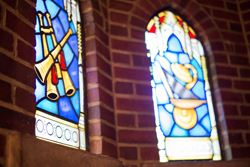 Installed in 1992, these three small lancets on the stair to the music loft contain fanciful images of Biblical musical instruments, and are a memorial to Ray Edward and Blanche Bail Mauger.
Installed in 1992, these three small lancets on the stair to the music loft contain fanciful images of Biblical musical instruments, and are a memorial to Ray Edward and Blanche Bail Mauger.